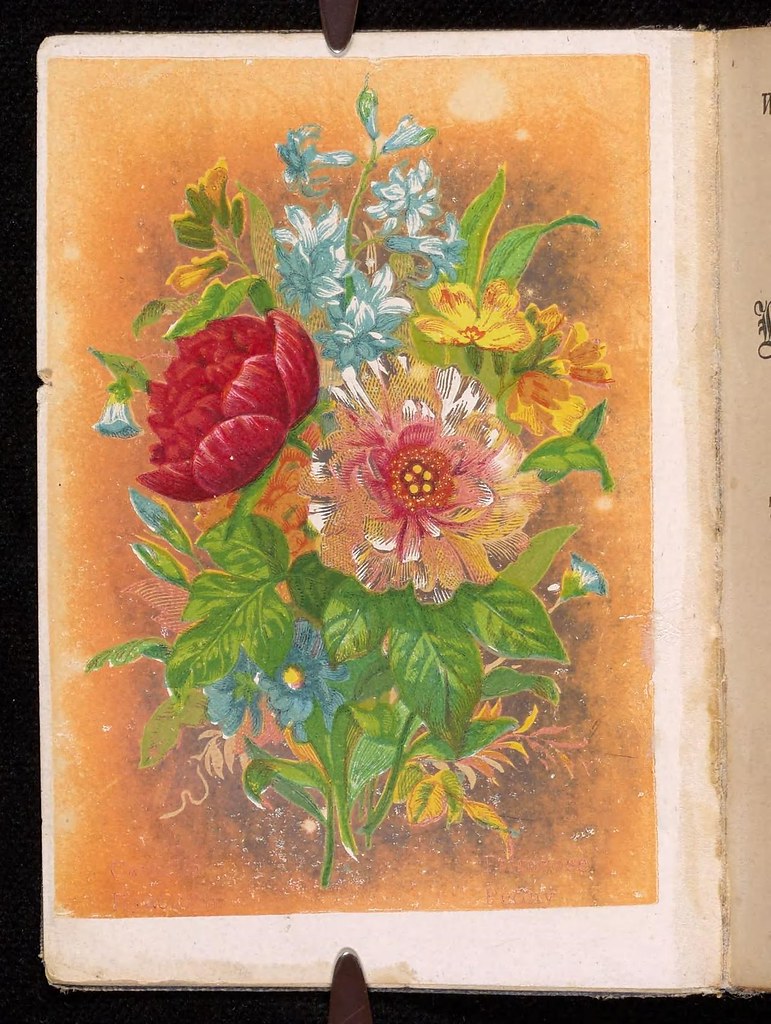#common chicory
Text
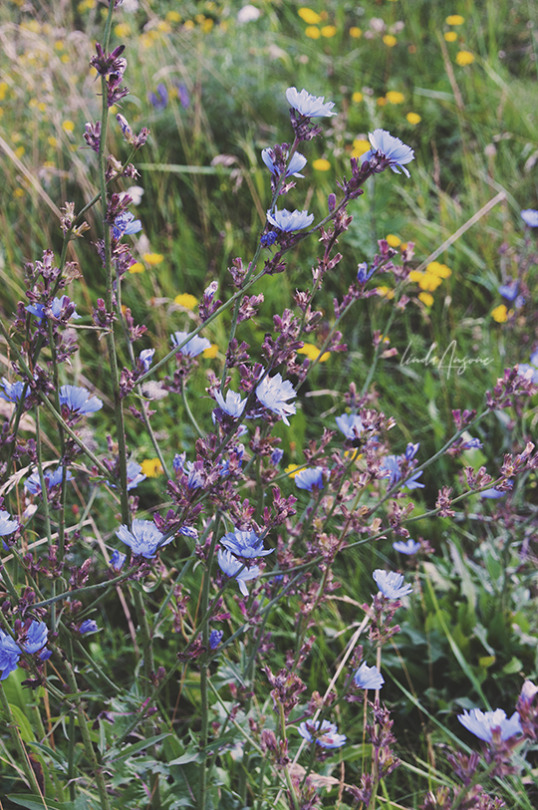


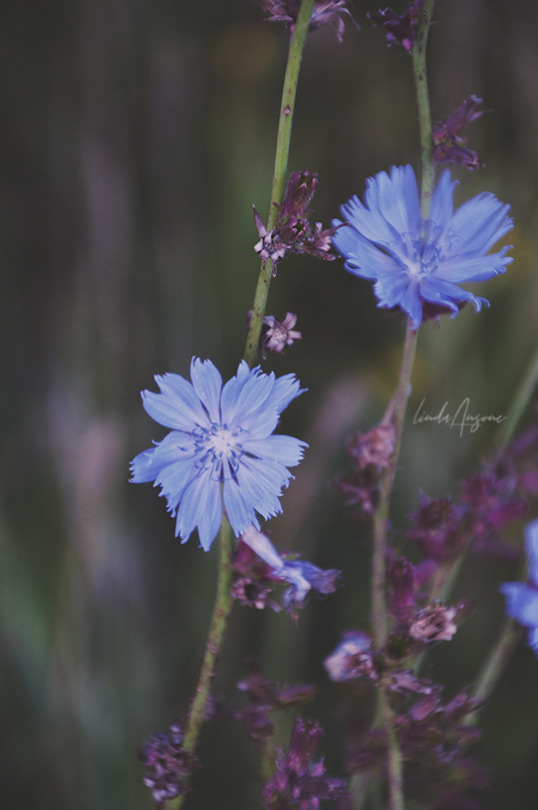
Common chicory
#chicory#common chicory#floral#flowercore#plantcore#wild plants#meadow#nature#nature photography#original photographers#photographers on tumblr
675 notes
·
View notes
Text
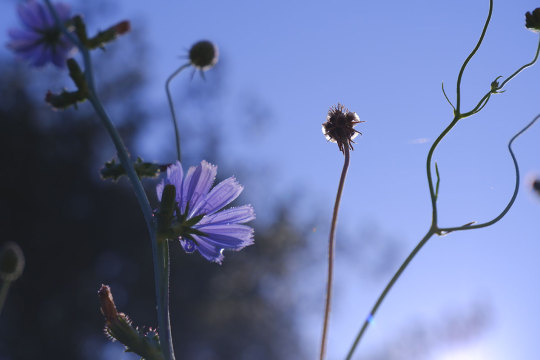

#chicory#common chicory#my photography#flowers#flower photography#plant photography#photography#blue#wildflowers#wild flowers
15 notes
·
View notes
Photo

Common Chicory, Wild Succory
Cichorium intybus
Asteraceae
Photograph taken on October 7, 2021, along the Culham Trail, Mississauga, Ontario, Canada.
#wildflowers of southern ontario#Common Chicory#chicory#Wild Succory#succory#Cichorium intybus#Cichorium#Asteraceae#wildflowers#flowers#wildflower#flower#purple#blue#culham trail#mississauga#ontario#canada
26 notes
·
View notes
Text
When people say "what's your favorite video game genre" I always assume they want a regular answer so I just say metroidvania because I love metroidvanias but my real favorite is "even the most insignificant characters have their own individual lives and this game makes sure you know that one way or another"
Edit hi it's present me. This post's tags need updating but I don't want to update the tags do I do it or no
#wandersong#oneshot#oneshot game#stardew valley#slime rancher#spiritfarer#uhhh what else#chicory#chicory a colorful tale#a short hike#i just KNOW i'm forgetting some#but i don't feel like figuring them all out right now#actually now that i think about it#this is super common in indie games#but kinda rare in games made by big corporations#hmmmmm#HMMMMMMMMMMMMMMMMMMM#i think i know why
2K notes
·
View notes
Text
It's starting to be more available now bc it's getting swept up in the health food craze but it's so annoying how ingredients/food that's traditional to the region is much harder to get than all the "exotic" food stuffs that are considered normal now
#like whaddayah meeeeaaaaannn brewed chicory was a common drink here for ages way before coffee was introduced#and now if I want it I have to go to the most etepetete organic expensive shop#same with buckwheat and millet although they sell it at Aldi now too#*exotic as in it doesn't grow here
11 notes
·
View notes
Note
idk if u play minecraft or ever will but im browsing mods and saw one that specifically panders to ppl with misophonia and thought "oh theres an artist i follow that has that i should send it to them" so here we are
modrinth (dot) com (slash) mod (slash) soundsbegone
:D
oh that's cool!!! i haven't been an active minecraft player in years and i don't remember any of their sounds bothering me much but i always appreciate stuff like that👍 i'm glad you thought of me :)
#i like that it's becoming a bit more common now#chicory having an option to turn off the squelchy noises the brush makes was super nice even tho i didn't need it#bri talks
7 notes
·
View notes
Video
n5_w1150 by Biodiversity Heritage Library
Via Flickr:
The Language of flowers : London :F. Warne,[18--?] biodiversitylibrary.org/page/60674408
#Flower language#Flowers in literature#Chicago Botanic Garden#Lenhardt Library#bhl:page=60674408#dc:identifier=https://biodiversitylibrary.org/page/60674408#language of flowers#flowers#bouquet#flower#flickr#rose#chicory#virginia bluebells#rosa#Mertensia virginica#evening primrose#Common evening-primrose#Oenothera biennis#peony#paeony#Paeonia#blue daisy#Felicia amelloides#blue felicia#golden sage#Salvia officinalis
2 notes
·
View notes
Text
The knowledge of some common plants
Since many people don't know most of the plants around them, this is information on some plants that are commonly seen in many places throughout the world

This is Lamium purpureum, also called Purple Deadnettle.
It's called deadnettle because it looks like a nettle but it doesn't sting you
This plant is a winter annual—it grows its leaves in the fall, lasts through the winter, and blooms and dies in the spring
Its pollen is reddish orange. If you see bees with their heads stained reddish orange, it is likely because they have visited Purple Deadnettle
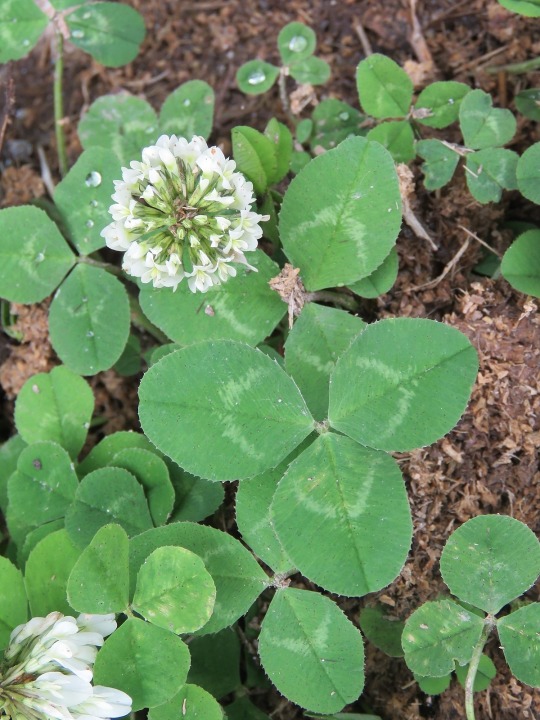
This is Trifolium repens, white clover
It is a legume (belongs to the bean family) and fixes nitrogen using symbiosis with bacteria that live in little nodules on its roots, fertilizing the soil
It is a good companion plant for the other members of a lawn or garden since it is tough, adaptable, and improves soil quality. According to my professor it used to be in lawn mixes, until chemical companies wanted to sell a new herbicide that would kill broadleaved plants and spare grass, and it was slandered as a weed :(
It is native only to Europe and Central Asia, but in the lawns they are doing more good than harm most places
Honeybees love to visit clover
Four-leaf clovers are said to be lucky
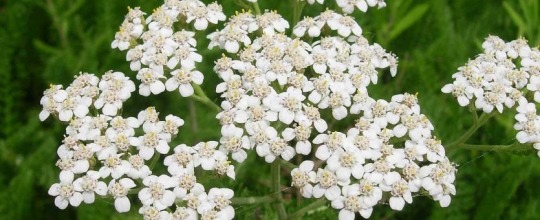
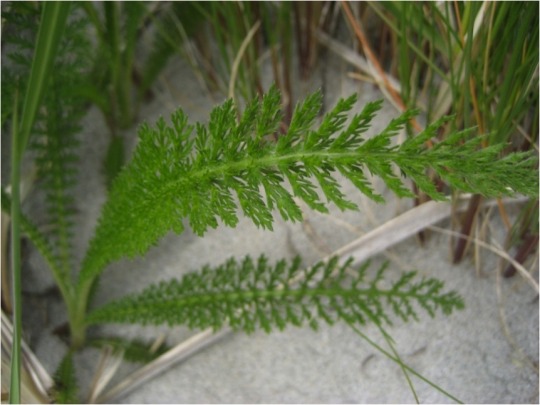
This is Achillea millefolium, Common Yarrow
It has had a relationship with humans since Neanderthals were around, at least 60,000 years, since Neanderthals have been found buried with Yarrow
Its leaves have been used to stop bleeding throughout history, and its scientific name comes from how Achilles was said to have used Yarrow to stop the blood from the wounds of his soldiers. A leaf rolled into a ball has been used to stop nosebleeds
It is a native species all throughout Eurasia and North America

This is Cichorium intybus, known as Chicory
The leaves look a lot like dandelion leaves, until in mid-spring when it begins growing a woody green stem straight up into the air
Like many other weeds, it has a symbiotic relationship with humans, existing in a mix of domesticated or partially domesticated and wild populations
It is native to Eurasia, but widespread in North America on roadsides and disturbed places, where it descended from cultivated plants
Its root contains large amounts of inulin, which is used as a sweetener and fiber supplement (if you look at the ingredients on the granola bars that have extra fiber, they usually are partly made of chicory root) and has also been used as a coffee substitute
A large variety of bees like to feed upon it

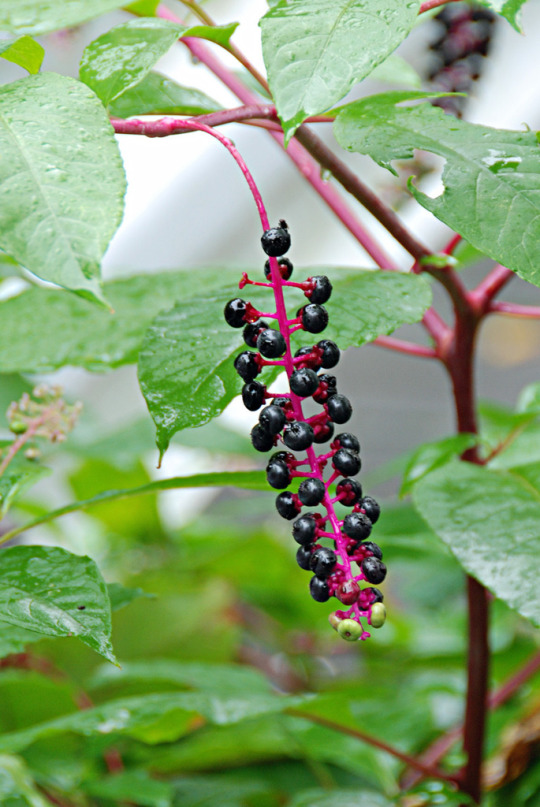
This is Phytolacca americana, known as Pokeweed
It is easily identified by its huge leaves and its waxy, bright magenta stem
It can grow more than nine feet tall from a sprout in a single summer!
If you squish the berries, the juice inside is a shocking magenta that is so bright it almost burns your eyes. For this reason many Native American people used it for pink and purple dye.
It is a heavy metal hyperaccumulator, particularly good for removing cadmium from the soil
All parts of the plant are poisonous and will make you very sick if you eat them, however if the leaves are picked when very young and boiled 3 times, changing out the water each time, they can be eaten, and this is a traditional food in the rural American Southeast, but I don't want to chance it
British people have introduced it as a pretty, exotic ornamental plant. I think that is very funny considering that here it is a weed associated with places where poor people live, but maybe they're right and I need to look closer to see the beauty.
If you see magenta stains in bird poop it is because they ate pokeweed berries- birds can safely eat the berries whereas humans cannot

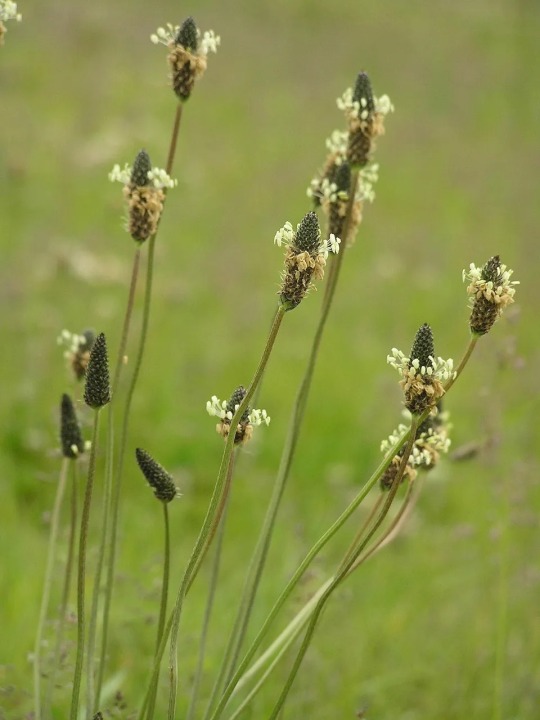
This is Plantago lanceolata, Ribwort Plantain
It grows in heavily disturbed soils, in fact it is considered an indicator of agricultural activity. It is successful in the poorest, heaviest and most compacted soil.
The leaves, seeds, and flower heads are said to be edible but the leaves are really stringy unless they are very young. Of course, it is important to be careful when eating wild plants, and make sure you have identified the plant correctly and the soil is not contaminated
I have also heard the strings in the leaves can be extracted and used for textile purposes
and that's some common plants you might often see throughout the world
#just remembered i had this in my drafts#i forget why i didn't post it immediately#anyway#plants#the ways of the plants
5K notes
·
View notes
Text
What's really in that witch's cauldron?
Folk names for herbs
Ass' Ear- Comfrey
Bat's Wing- Holly Leaves
Beard Of Monk- Chicory
Bear's Foot- Lady's Mantle
Bird's Eye- Germander or Speedwell
Blind Eyes- Poppy
Blood From a Head- Lupine
Blood Of Ares- Purslane
Blood Of Hestia- Chamomile
Bloody Fingers- Foxglove
Calf's Snout- Snapdragon
Cat's Foot- Ground Ivy
Crow's Foot- Wood Anemone
Devil's Ear- Jack In The Pulpit
Devil's Plaything- Yarrow
Dew Of the Sea- Rosemary
Dog's Mouth- Snapdragon
Dragon's Teeth- Vervain
Elf Leaf- Lavender
Englishman's Foot- Common Plantain
Fairy Eggs- Nutmeg
Flower Of Death- Vinca
Goose Tongue- Lemon Balm
Graveyard Dust- Mullein
Hawk's Heart- Wormwood
Juno's Tears- Vervain
Jupiter's Beard- Sempervivums
Lion's Foot- Lady's Mantle
Little Faces- Viola
Man's Bile- Turnip Sap
Mortification Root- Rose of Sharyn
Nose Of Turtle- Turtlehead, Chelone
Nosebleed- Yarrow
Our Lady's Tears- Lily Of The Valley
Old Man's Flannel- Mullein
Ram's Head- Valerian
Scale Of Dragon- Tarragon
Semen Of Ares- White Clover
Semen Of Hermes- Dill
Serpent's Tongue- Dog's Tooth Violet
Sparrow's Tongue- Knotweed
Tree Of Doom- Elder
Unicorn Root- Boneset
Weasel Snout- Yellow Archangel
Wool Of Bat- Moss
Body Parts as Plants:
Eye- Blossom or Seed
Heart- Bud or Seed
Beak, Bill or Nose- Seed, Bud or Bloom
Tongue or Teeth- Petal or Leaf
Head- Blossom
Tail- Stem
Hair- Dried Herbs or Stringy Parts Of Herbs
Privates, Genitals Or Semen- Seeds Or Sap
Blood- Sap
Guts- Roots or Stalk
Paw, Foot, Leg, Wing or Toe- Leaves
Animals as Plants:
Toad- Sage
Cat- Catmint
Dog- Grasses, Specifically Couchgrass
Frog- Cinquefoil
Eagle- Wild Garlic
Blue Jay- Laurel
Hawk- Hawkweed
Lamb-Wild Lettuce
Nightengale- Hops
Rat- Valerian
Weasel- Rue
Woodpecker- Peony
I borrowed this from:
#witchcore#witchy#witchcraft#witch#witchblr#magick#cast spells#moon#crystals#moon magic#witches of tumblr#witches#witchyvibes#kitchen witch#witch community#witch tips#witchaltar#witchlife#witchythings#spells#grimoire#spellcraft#cleansing#spellwork#witch tip#my spells#herbsforspells#herbs#herbalist#witch herbs
8K notes
·
View notes
Text

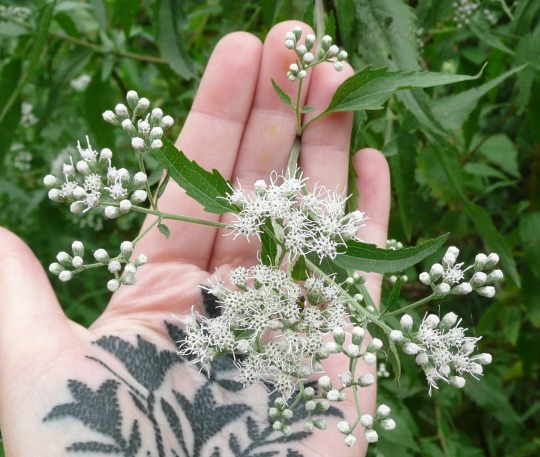
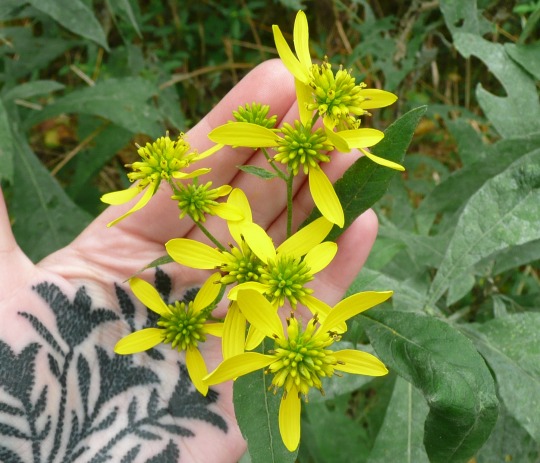


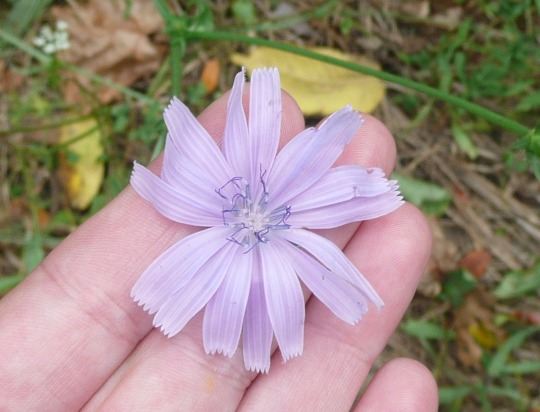
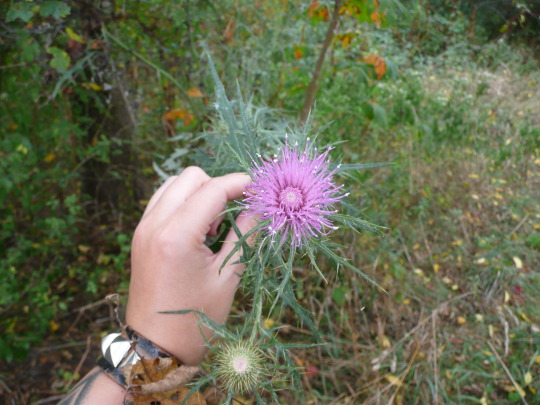

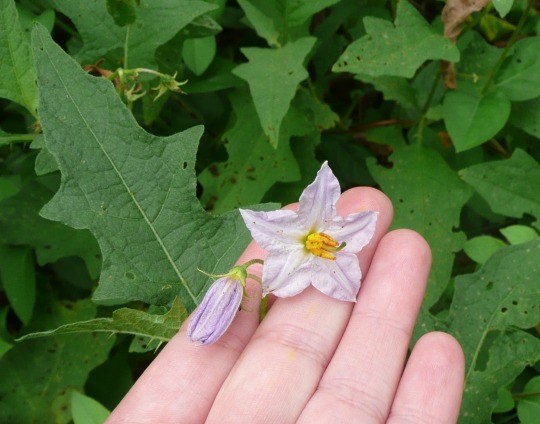


Mid-September ridgetop hayfield flora:
White snakeroot, late boneset, wingstem
Pearly everylasting, grass-leaved goldenrod, chicory
Thistle, wild carrot, horse nettle
Common milkweed, honey locust
856 notes
·
View notes
Text
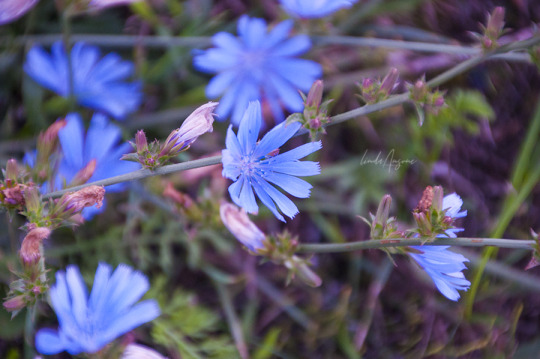


Common chicory
#chicory#Common chicory#floral#flowercore#plantcore#wild plants#nature#nature photography#original photographers#photographers on tumblr#summer
330 notes
·
View notes
Text


#common chicory#chicory#flowers#flower photography#plant photography#my photography#photography#meadow#wildflowers#wild flowers
11 notes
·
View notes
Text
English Folk/Traditional Names for Common Plants & Herbs

These are known now as folk names, but back in the medieval era and well into the 18th century, these were the common names for some of the herbs and plants in use in witchcraft (and generally!) today.
This list is not an exhaustive one; the names given here are just some of the names that were used primarily in England for common plants within the region.These plants have other unique and wonderful names in many other cultures and languages throughout the world.
✧ ADDER’S TONGUE (Ophioglossum Vulgatum)
A.K.A.: English Adder’s Tongue, Snake’s Tongue, Viper’s Tongue, Serpent’s Tongue, Adder’s Spear, Christ’s Spear.
✧ AGRIMONY (Agrimonia Eupatoria)
A.K.A.: Harvest Lice, Cat’s Tail, Liverwort, Sticklewort, Stickwort, Stickweed, Fairy’s Wand, Church Steeples, Aaron’s Rod, Beggar’s Lice/Ticks.
✧ ALDER (Alnus Glutinosa)
A.K.A.: Black Alder, Fever Bush, Owler.
✧ ANGELICA (Angelica Archangelica)
A.K.A.: Holy Ghost/Root of the Holy Ghost, St. Michael’s flower, Angel’s Food.
✧ ANISE (Pimpinella Anisum)
A.K.A.: Sweet Alice, Aniseed.
✧ APPLE (Malus)
A.K.A.: Fruit of the Gods, Fruit of the Underworld, Silver Branch, Silver Bough.
✧ ASH (Fraxinus Excelsior)
A.K.A.: Bird’s Tongue, Hampshire Weed, Widow-maker, Venus of the Woods, Husbandman’s tree.
✧ BALSAM (Commiphora Opolbalsamum)
A.K.A.: Balsam of Gilead, Balm Tree, Mecca Myrrh.
✧ BASIL (Oscimum Basilicum)
A.K.A.: Our Herb, St. Joseph’s Wort, Witches’ Herb, King of Herbs, Holy Basil.
✧ BAY (Laurus Nobilis)
A.K.A.: Bay Laurel, True Laurel, Daphne, Noble Laurel.
✧ BERGAMOT (Monarda Didyma)
A.K.A.: Horsebalm, Bee Balm, Scarlet Mondara.
✧ BIRCH (Betula Pendula)
A.K.A.: Silver Birch, White Birch, Lady of the Woods.
✧ BITTERSWEET (Solanum Dulcamara)
A.K.A.: Woody Nightshade, Felon-wort, Felonwood, Blue Nightshade, Fever Twig, Staff Vine, Violet Bloom.
✧ BLACKBERRY (Rubus Fruticosus)
A.K.A.: Bramble, Fingerberry, Blackhide, Blackbutter, Thimbleberrym Brambleberry, Gouthead.
✧ BLUEBELL (Hyacinthoides Non Scrupta)
A.K.A.: Nodding Squill, Auld Man’s Bell, Ring-o-bells, Wood Bells.
✧ BROOM (Cytisus Scoparius)
A.K.A.: Besom, Irish Tops, Scotch Broom, Butcher’s Broom, Sweet Broom.
✧ BURDOCK (Arctium Lappa)
A.K.A.: Thorny Burr, Beggar’s Buttons, Sticky Bobs, Love Leaves, Hare Burr.
✧ CARNATION (Dianthus Caryophyllus)
A.K.A.: Gilliflower, July Flower, Clove Pink, Sops-in-wine.
✧ CHAMOMILE (Anthemis Nobilis)
A.K.A.: Whig Plant, Chamomel, Earth/Ground Apple,
✧ CHESTNUT [SWEET] (Castanea Sativa)
A.K.A.: Marion, Jupiter’s Nut.
✧ CHICKWEED (Stellaria Media)
A.K.A.: Starweed, Adder’s Mouth, Scarweed/wort, Tongue Grass, Stitchwort, White Bird’s Eye, Little Star Lady.
✧ CHICORY (Cichorium Intybus)
A.K.A.: Witloof, Blue Sailors, Coffeeweed.
✧ CLARY [WILD] (Salvia Verbenaca)
A.K.A.: Christ’s Eye, Wild Clear-eye, Vervain Sage, Eyeseed.
✧ CLEAVERS (Galium Aparine)
A.K.A.: Catchweed, Beggar Lice, Goose Grass, Sticky Willy, Bedstraw, Robin-run-the-hedge, Goose’s Hair, Hedge-burrs, Milk Sweet, Stick-a-back, Scratchweed, Barweed.
✧ COMFREY (Symphytum Officinale)
A.K.A.: Knitbone, Slippery Root, Blackwort, Bruisewort, Ass Ear.
✧ DAISY (Bellis Perennis)
A.K.A.: Day’s Eye, Poet’s Darling, Bachelor’s Buttons, Bairnwort, Billy Buttons, Boneflower, Margaret’s Herb.
✧ DANDELION (Taraxacum Officinale)
A.K.A.: Swine’s Snout, Blowball, Puffball, Clockflower, Tell-the-time, Priest’s Crown, Lion’s Tooth.
✧ DEADLY NIGHTSHADE (Atropa Belladonna)
A.K.A.: Belladonna, Banewort, Black-cherry, Devil’s Cherries, Naughty Man’s Cherries, Devil’s Herb.
✧ FEVERFEW (Tanacetum Parthenium)
A.K.A.: Featherfew, Featherfoil, Midsummer Daisy, Nosebleed.
✧ FOXGLOVE (Digitalis Purpurea)
A.K.A.: Fairy Gloves/Fingers/Petticoats/Thimbles/Weed, Witches’ Glove, Witches’ Bells, Our Lady’s Glove, Dead Men’s Bells.
✧ GARLIC (Allium Sativum)
A.K.A.: Poor Man’s Treacle, Stinkweed, Camphor of the Gods.
✧ GOLDENROD (Solidago Vibgaurea)
A.K.A.: Aaron’s Rod, Cast the Spear.
✧ HAWTHORN (Crataegus Monogyna)
A.K.A.: May Blossom, Mayflower, Whitethorn, Hagthorn, Ladies’ Meat.
✧ HELLEBORE [BLACK] (Helleborus Niger)
A.K.A.: Bear’s Foot, Setter-wort/grass.
✧ HEMLOCK (Conium Maculatum)
A.K.A.: Poison Hemlock, Devil’s Porridge.
✧ HENBANE (Hysoscyamus Niger)
A.K.A.: Hog Bean, Stinking Nightshade, Henbell, Devil’s Eye, Witches’ Herb, Devil’s Tobacco.
✧ HOLLY (Ibex Auifolium)
A.K.A.: Bat’s Wings, Holy Tree, Christ’s Thorn.
✧ HONEYSUCKLE (Lonicera Periclymenum)
A.K.A.: Woodbind, Fairy Trumpets, Sweet Suckle, Honeybind.
✧ HOREHOUND [BLACK] (Ballota Nigra)
A.K.A.: Madwort, Black Hoarhound, Black Archangel.
✧ HOREHOUND [WHITE] (Marrubium Vulgare)
A.K.A.: Bull’s Blood, White Archangel, Eye of the Star, Houndbane, Devil’s Eye.
✧ IVY (Hedera Helix)
A.K.A.: Gort, Bindwood, Lovestone.
✧ JUNIPER (Juniperus Communis)
A.K.A.: Bastard Killer, Gin Berry.
✧ LADY’S MANTLE (Alchemilla Vulgaris)
A.K.A.: Our Lady’s Mantle, Lion’s Foot, Bear’s Foot, Nine Hooks.
✧ LAVENDER (Lavendula Angustifolia)
A.K.A.: Elf Leaf, Spikenard, True Lavender.
✧ LEMON BALM (Melissa Officinalis)
A.K.A.: Sweet Melissa, Bee Balm, Sweet Balm.
✧ LEMON VERBENA (Aloysia Triphylla)
A.K.A.: Lemon Louisa, Lemon Beebrush.
✧ LILY OF THE VALLEY (Convallaria Majalis)
A.K.A.: May Lily, Our Lady’s Tears, Mary’s Tears, Ladder to Heaven.
✧ MALLOW (Malva Sylvestris)
A.K.A.: Cheese-cake, Pick-cheese, Round Dock, Wild Mallow, Wood Mallow.
✧ MANDRAKE (Mandragora Officinarum)
A.K.A.: Satan’s Apple, Love Plant, Mandragora.
✧ MARIGOLD (Calendula Officinalis)
A.K.A.: Bride of the Sun, Drunkard, Husbandman’s Dial, Mary Gold, Summer’s Bride.
✧ MARJORAM (Origanum Majorana)
A.K.A.: Wintersweet, Joy of the Mountain, Mountain Mint.
✧ MEADOWSWEET (Filipendula Ulmaria)
A.K.A.: Bridewort, Queen of the Meadows, Little Queen, Quaker Lady, Mead Sweet, Gravel Root.
✧ MINT [PEPPERMINT] (Mentha Piperita)
A.K.A.: Brandy Mint, English Mint.
✧ MINT [SPEARMINT] (Mentha Spicata)
A.K.A.: Garden Mint, Hart Mint, Our Lady’s Mint, Sage of Bethlehem.
✧ MISTLETOE (Viscum Coloratum)
A.K.A.: Druid’s Herb, Witches’ Broom, Wood of the Cross, Golden Bough, Devil’s Fuge.
✧ MONKSHOOD (Aconitum Napellus)
A.K.A.: Monk’s Blood, Blue Wolf’s-bane, Aconite, Women’s Bane, Devil’s Helmet, Friar’s Cap.
✧ MUGWORT (Artemisia Vulgaris)
A.K.A.: Lion’s Tail, Lion’s Tart, Heart-wort.
✧ MULLEIN (Verbascum Thapsus)
A.K.A.: Blanket/Velvet/Woolly Mullein, Our Lady’s Blanket, Beggar’s Blanket, Aaron’s Rod, Adam’s Rod, Jupiter’s Staff, Jacob’s Staff, Peter’s Staff, Virgin Mary’s Candle, Lady’s Foxglove, Graveyard Dust.
✧ NETTLE (Urtica Dioica)
A.K.A.: Stinging Nettle, Burn Weed, Burn Hazel.
✧ PARLSEY (Petroselinum Crispum)
A.K.A.: Devil’s Oatmeal, Persil.
✧ PENNYROYAL (Mentha Legium)
A.K.A.: Royal Thyme, Run-by-the-ground, Lurk-in-the-ditch, Pudding Grass.
✧ ROSEMARY (Rosemarinus Officinalis)
A.K.A.: Dew of the Sea, Sea Dew, Elf Leaf, Guardrobe, Rose of Mary.
✧ RUE (Ruta Graveolens)
A.K.A.: Herb of Grace, Herb of Repentance, Mother of Herbs.
✧ [CLARY] SAGE (Salvia Sclarea)
A.K.A.: Clear-Eye, See-bright, Eyebright.
✧ ST. JOHN’S WORT (Hypericum Perforatum)
A.K.A.: Scare-devil, Balm of the Warrior’s Wound, Rose of Sharon.
✧ SORREL (Rumex Acetose)
A.K.A.: Green Sauce, Sour Sauce, Cuckoo Sorrow.
✧ SWEET WOODRUFF (Galium Odoratum)
A.K.A.: Wild Baby’s Breath, Master of the Woods, Ladies in the Hay.
✧ TANSY (Tanacetum Vuulgare)
A.K.A.: Bitter Buttons, Golden Buttons, Cow Bitter.
✧ TARRAGON (Artemisia Dracunculus)
A.K.A.: Dragon’s Wort, Little Dragon.
✧ THISTLE [BLESSED] (Cnicus Benedictus)
A.K.A.: Holy Thistle.
✧ THISTLE [MILK] (Silybum Marianum)
A.K.A.: Our Lady’s Thistle, Saint Mary’s Thistle, Sow Thistle, Marian Thistle.
✧ VALERIAN (Valeriana Officinalis)
A.K.A.: Garden Heliotrope, St. George’s Herb, Bloody Butcher, Cat’s Valerian, Vandal Root.
✧ VERVAIN (Verbena Officinalis)
A.K.A.: Herb of Grace, Enchanter’s Herb, Britannica, Juno’s Tears, Divine Wood, Pigeongrass,
✧ WITCH HAZEL (Hamamelis Virginiana)
A.K.A.: Spotted Alder, Winterbloom, Snapping Hazelnut.
✧ WORMWOOD (Artemisia Absinthium)
A.K.A.: Absinthe, Crown for a King, Green Ginger.
✧ YARROW (Achillea Millefolium)
A.K.A.: Woundwort, Nose-Bleed, Thousand-Leaf, Arrowroot, Carpenter’s Weed, Devil’s Plaything, Devil’s Nettle,
Sources, References and Cross-Checks: Breverton's Complete Herbal (Terry Breverton), Encyclopedia of Magical Herbs (Scott Cunningham), Medieval Plant Names and Their Modern Corollaries (The Met Cloister).
If you like my content and would like to help me keep providing free stuff for my gorgeous Ghoul Gang, you can tip your witch here: [Paypal].
699 notes
·
View notes
Text
Running a lil experiment!
I've noticed that I like a lot of niche games. I've also noticed this is true for other people in the fandom. Below the cut are a list of niche/underrated games I like. Reblog/comment with games you play or niche games not on the list! This could be a good way to find people with common interests!
Bug Fables: The Everlasting Sapling
TUNIC
Spiritfarer
Sundered
The Last Campfire
Rain World
Monster Sanctuary
The Pathless
ABZU
Cocoon
Strange Horticulture
Death's Door
Chicory: A Colorful Tale
OneShot
Chants of Sennar
Swarm
Spirit of the North
Webbed
Carrion
Lost Ember
Wandersong
#it's a long list#murder drones#murder drones au#murder drones fandom#reblog or comment games you play that are on this list#or reblog with games you feel are underrated and not on this list#daze barks#gaming#video games
19 notes
·
View notes
Text

18 notes
·
View notes
Note
hey what do you think of cpc characters as flowers,, maybe plaid family specifically. the sunflower post had me thinking
!!!!!!!!! CPC as flowers!!!!!!! YES. yes yes yes. oh my gosh. CPC as flowers >>>
gonna do the plaid family rn :D
FIRST;;; Lance!! the ultimate middle child, my boy

I feel like Chicory would really represent him well!
it's a wildflower (which I think fits him) and it belongs to the Sunflower family. it's name, according to a Trusty Google Search, means, "The German word for chicory means “The Blue Lookout at the Wayside.”
It's a cool season veggie and prefers a sunny location (Lance being a Sunshine boy my beloved). the nicknames for Chicory are, "Chicory is also called blue daisy, blue sailor, wild bachelor's button, blue or Italian dandelion, or even coffeeweed" (all of which I think kinda fit Lance)
"Chicory has also been used to symbolize the force of perseverance in martyrdom, as seen on the St Augustine's altar from 1487" - some study from 2009
NEXT:: Isolde!! :D

carnations!! specifically red carnations!! these symbolize deep love and affection, and the ruffles at the end of the petals really remind me of her.
There's also this little bit of info, "The color was thought to resemble human flesh and carnation flower meaning took on the idea of the incarnation, God being made flesh." WHICH. I think is pretty baller NGL.
Next: Blaine!!

I picked this because 1. It does resemble a carnation, which I felt was a nice detail :D (esp since he resembles his mother the most!!) and 2. red roses are known for a lot of things, like love and passion and stuff, AND red roses are often associated with throwing them at the end of plays and movies, which I find fits him!!!
"The red rose whispers of passion, And the white rose breathes of love; O, the red rose is a falcon, And the white rose is a dove." - some poem that makes me go a little Cray. and there's also this: "It's the rose of romance and deep feelings, but can also relay desire, beauty, victory, harmony, joy, luck, pride, martyrdom, [according to McCord Jones.]"
They thrive off direct sunlight and take a while to grow :D pretty high maintenance flowers yk :D PLUS!!!! they're super pretty and soft-looking, but they have thorns!!
FREDERICK....

A Green Jewel Coneflower :D okay I was mildly tempted to just put a sunflower BUTTT you know. So I picked this!!!
a Green Jewel Coneflower can pretty much grow anywhere (and it grows pretty tall too!!), and they actually like a little bit of shade!
Sources say this: "Today, the Orange Coneflower is a symbol of enthusiasm and vitality. Its bold hue radiates excitement, making it a perfect emblem for those eager to make a statement. It's not just a pretty face; it's a nod to resilience, attracting pollinators and feeding birds, while standing strong against deer and drought." Which I think really suits him!!
and,
Leland..... bro would be like poison or something. Actually, maybe he'd be like a Petunia- "A flower that is not very common, Petunias display feelings of deep resentment and anger." It's not a poisonous flower but I feel like the negative meaning of it fits him :D
#cursed princess club#cpc blaine#cpc isolde#cpc lance#cpc Frederick#flowers!!#brief mention of leland
13 notes
·
View notes
